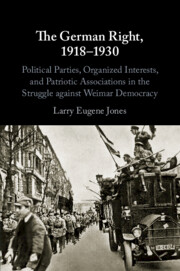 The German Right, 1918–1930
The German Right, 1918–1930 Book contents
- The German Right, 1918–1930
- The German Right, 1918–1930
- Copyright page
- Dedication
- Contents
- Figures
- Acknowledgments
- Abbreviations
- Introduction
- 1 Revolution and Realignment
- 2 Infrastructure of the German Right
- 3 Forging a Conservative Synthesis
- 4 Growth and Consolidation
- 5 The Radical Right
- 6 1923 – A Missed Opportunity?
- 7 From Triumph to Schism
- 8 Stabilization from the Right?
- 9 Paladins of the Right
- 10 A Resurgent Nationalism
- 11 The Road Back to Power
- 12 The Burden of Responsibility
- 13 From Defeat to Crisis
- 14 Reverberations and Realignment
- 15 The Chimera of Right-Wing Unity
- 16 Schism and Fragmentation
- 17 The Brüning Gambit
- 18 The September Earthquake
- Epilogue
- Select Bibliography
- Index
2 - Infrastructure of the German Right
Published online by Cambridge University Press: 21 March 2020
- The German Right, 1918–1930
- The German Right, 1918–1930
- Copyright page
- Dedication
- Contents
- Figures
- Acknowledgments
- Abbreviations
- Introduction
- 1 Revolution and Realignment
- 2 Infrastructure of the German Right
- 3 Forging a Conservative Synthesis
- 4 Growth and Consolidation
- 5 The Radical Right
- 6 1923 – A Missed Opportunity?
- 7 From Triumph to Schism
- 8 Stabilization from the Right?
- 9 Paladins of the Right
- 10 A Resurgent Nationalism
- 11 The Road Back to Power
- 12 The Burden of Responsibility
- 13 From Defeat to Crisis
- 14 Reverberations and Realignment
- 15 The Chimera of Right-Wing Unity
- 16 Schism and Fragmentation
- 17 The Brüning Gambit
- 18 The September Earthquake
- Epilogue
- Select Bibliography
- Index
Summary
Chapter 2 examines the infrastructure of the German Right with particular attention on the integration of industry, agriculture, Christian labor, and the different sectors of the German middle class into the organizational structure of the DNVP. It also deals with the way in which industry, agriculture, Christian labor, and the German middle classes organized themselves in order to represent their special interests within the framework of Germany’s new republican order. The high degree of interest articulation that this involved, however, subjected the DNVP to centrifugal pressures that were sometimes difficult contain and that posed a threat to the party’s unity and political effectiveness. Still, the DNVP was remarkably successful in anchoring itself in Germany’s conservative milieu since its founding a year and a half earlier and was well on its way to developing into a socially heterogeneous conservative Sammelpartei. Interest articulation that this involved, however, subjected the DNVP to centrifugal pressures that were sometimes difficult contain and that posed a threat to the party’s unity and political effectiveness. Still, the DNVP was remarkably successful in anchoring itself in Germany’s conservative milieu in the short period since its founding and was well on its way to developing into a socially heterogeneous conservative Sammelpartei.
Keywords
- Type
- Chapter
- Information
- The German Right, 1918–1930Political Parties, Organized Interests, and Patriotic Associations in the Struggle against Weimar Democracy, pp. 48 - 76Publisher: Cambridge University PressPrint publication year: 2020
